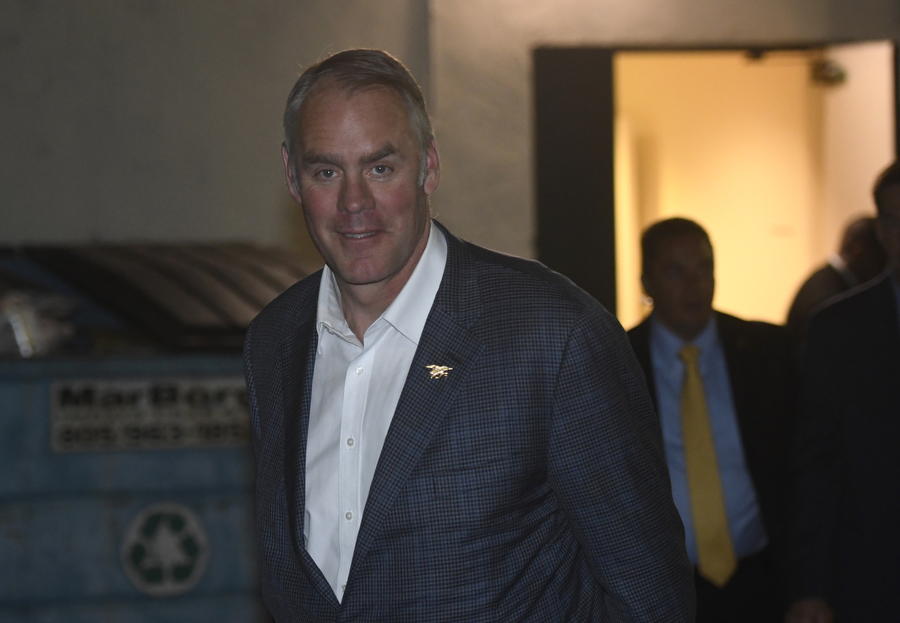Stinky Zinke Forced Out
Saying Goodbye to Bad Rubbish, But He’s Not the Problem

It’s been too much fun hating on Ryan Zinke, Donald Trump’s recently forced-out Secretary of the Interior and a peripatetic Mesa rat. Zinke stepped down amid an eruption of alleged ethical scandals, which, real or imagined, would have been excruciatingly explored by the new Democratic majority. Cocky, swaggering, and insufferably self-enraptured, Zinke went out swinging. When Raúl Grijalva — the ranking Democrat on the Natural Resources Committee — recently called for Zinke’s resignation, Zinke tweeted back it must be hard for Grijalva “to think straight from the bottom of a bottle.” Grijalva, for the record, was hit by the incoming tweet while parked on a barstool at his favorite D.C. watering hole, the Tune Inn.
Whether it’s optics or ethics, Zinke’s have been uniformly awful. He famously rode his horse to work on Day One. Tellingly, his cowboy hat was screwed on backward. Zinke had a special flag installed at the Department of Interior; when he was on premises, the flag was hoisted; when he left, it came down. Zinke, undeniably, was charming, charismatic, and cutthroat. The question remains whether he is also corrupt.
Yes, he and his wife partnered with the CEO of Halliburton — the largest oil-supply company in the world — in a sweetheart real-estate development project slated for his hometown of Whitefish, Montana. Turns out, Zinke was going to get a new microbrewery out of the arrangement in exchange for “donating” a few parking spaces from a nonprofit he started on behalf of veterans. As a conflict of interest, it couldn’t be more obvious. The person in charge of all onshore and offshore oil and gas drilling on public lands — Zinke — should never be entwined with a major petro-potentate.
Personally, I think Zinke’s stupid but clean. He did not need bribes to give away the national treasure to the likes of Halliburton. He’d have done it for nothing. Zinke was a true believer when it came the United States’ “energy dominance.” Phrases like that helped Zinke get under the skins of pointy-headed Prius drivers. Aside from that, he didn’t get much accomplished. Sure, he “opened up” all federal offshore oil leases to new oil-industry bidding; but given the multiplicity of state safeguards, no oil company would bother.
The real danger in hating the likes of Zinke is that doing so allows us to feel so good about doing so little. This was made manifest at the county supervisors’ meeting last week, when pretty much everyone was shocked to hear Santa Barbara’s greenhouse-gas emissions were 29 percent higher than where they should be by 2020. By 2020, our emissions are supposed to drop 15 percent below what they were in 2007. Last year, it turns out, they were 14 percent higher than 2007 levels. For the so-called birthplace of the Environmental Movement, that’s a deal killer. “How can that be?” supervisors wailed. Supervisor Das Williams suggested the “poseur” theory of environmentalism. We all talk a good game, but little more. Williams repeatedly blurted out the initials “VMT.” That stands for vehicle miles traveled, and we’re doing more of it to trigger a 12 percent increase in our metric tonnage of carbon dioxide emissions. There were other contributors. Since the drought, farmers have nearly tripled their use of fertilizers, which emit GHGs — even while reducing the acreage under cultivation by five percent. For reasons not understood, we’re using far more natural gas to heat existing buildings. But by far the most GHGs come from our VMTs — 46 percent — so that’s serious. Williams blamed all the people driving to and from work alone. Visually, he said, they make up 97 percent of the cars on the road. (The experts, I think, put it at 72 percent.) This, he said, goes to the whole jobs/housing imbalance, in which 12,000 Venturans a day drive to and from their jobs in Santa Barbara.
It’s been because of that flow of frustrated and infuriated drivers that we are spending $600 million to $800 million to widen Highway 101. After last week’s supervisors meeting, I got two calls from critics of that project, charging that the wider freeway will only make our GHG problem that much worse. According to the environmental impact report for that project, carbon dioxide emissions will nearly double between 2009 and 2040 if the freeway is widened — from 4,700 tons a year to 8,000. By contrast, the same environmental document suggests that if the project were not built, GHGs would go up but by a lot less, from 4,700 to 6,500. That’s a difference of almost 1,300 tons a year. That sounds like a lot, and it is. But coincidentally, it’s also how much the planet generates every second of every day.
To be fair — if confusing — Caltrans has since generated other numbers that contradict the numbers included in the project EIR. In a grant application to the state Transportation Commission last year, Caltrans stated that emission along the widened stretch of Highway 101 would decrease — not increase — by 481,000 tons over the next 20 years. Translated, that’s almost as much as all cars on the freeway generate in a given year, or a net reduction of about 24,000 tons a year.
It’s puzzling that the same state agency could release such dramatically opposing statistics on the same project in such a short period of time. The new numbers are said to reflect the role of electric cars.
It will be nice not having Ryan Zinke to kick around anymore. But clearly the backside to which our feet should be most swiftly applied is our own. Merry Christmas. Ouch!



